GMEG - Geology, Minerals, Energy, & Geophysics Science Center
  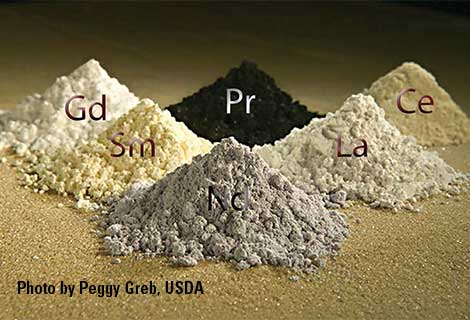 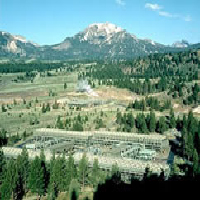  |
Scientists with the GMEG Science Center work on issues related to geologic processes and mineral and energy resource potential, primarily in the western United States. The science staff includes geologists, geophysicists, geochemists, biologists, GIS and remote sensing specialists who are located in offices in several states. Learn more about our scientific capabilities.Select a topic below for project and publications information |
ProjectsMore projects and publications from the Energy Resources program |
   |
| Science Center Director: Colin Williams | Office (650) 329-4881 - Cell (650) 888-3755 | |
| Deputy Director: Tom Frost | (509) 368-3103 | |
| Administrative Officer: Kimberly Jenkins | (509) 368-3104 | |
| Outreach Coordinator: Dave Frank | (509) 368-3107 | |
GMEG Science Center staff directory |
||
Answers for general science questions can be found at http://ask.usgs.gov/ or by calling 1-888-ASK-USGS.
Additional contact information can be retrieved from the USGS Electronic Directory.
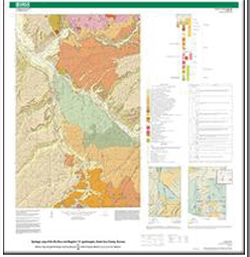 |
Geologic map of the Rio Rico and Nogales 7.5’ quadrangles, Santa Cruz County, Arizona The Rio Rico and Nogales (Arizona) 1:24,000-scale quadrangles are located in the Basin and Range Province of southern Arizona, and the southern edge of the map is the international border with Sonora, Mexico. The major urban area is Nogales, a bi-national city known as “the gateway to Mexico.” Rocks exposed in the map area range in age from Jurassic through Quaternary. Major physiographic, geologic, and hydrologic features in the map area include the southern San Cayetano Mountains, Grosvenor Hills, and Sonoita Creek in the northern part, and Mount Benedict and the Mount Benedict horst block in the southcentral part. The horst block is bounded by the Santa Cruz River on the east and Nogales Wash on the west.
|
 |
On April 25, 2015, a large (M7.8) earthquake shook much of central Nepal and was followed by a series of M>6 aftershocks, including a M7.3 event on May 12, 2015. This earthquake and aftershocks, referred to as the “Gorkha earthquake sequence,” caused thousands of fatalities, damaged and destroyed entire villages, and displaced millions of residents. The earthquakes also triggered thousands of landslides in the exceedingly steep topography of Nepal; these landslides were responsible for hundreds of fatalities, and blocked vital roads and trails to affected villages (fig. 1). Landslides caused by the Gorkha earthquake sequence continue to pose both immediate and long-term hazards to villages and infrastructure within the affected region. Some landslides blocked rivers and thus created another potential concern for villages located downstream. With the support of the United States Agency for International Development (USAID), Office of Foreign Disaster Assistance (OFDA), and in collaboration with earthquake-hazard organizations from both the United States (for example, U.S. National Science Foundation Geoengineering Extreme Event Reconnaissance [GEER] Team) and Nepal (International Centre for Integrated Mountain Development [ICIMOD]), the U.S. Geological Survey (USGS) responded to this crisis by providing landslide-hazard expertise to Nepalese agencies and affected villages. In addition to collaborating with an international group of remote-sensing scientists to document the spatial distribution of landsliding in the first few weeks following the earthquake, the USGS conducted in-country landslide hazard assessments for 10 days beginning May 24, 2015. Much of the information obtained by the USGS during their time in Nepal was conveyed directly to affected villages and government agencies as opportunities arose. Upon return to the United States, data organization, interpretation, and synthesis began immediately to provide a rapid assessment of landslide hazards for use by Nepalese agencies during the 2015 summer monsoon (typically occurring from June through September). |
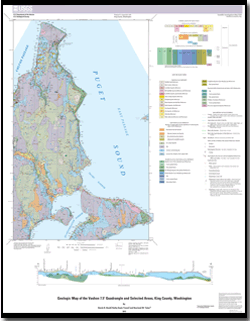 |
Geologic Map of the Vashon 7.5' Quadrangle and Selected Areas, King County, Washington This map is an interpretation of a 6-ft-resolution lidar-derived digital elevation model combined with geology by Derek B. Booth and Kathy Goetz Troost. Field work by Booth and Troost was located on the 1:24,000-scale topographic map of the Vashon and Des Moines 7.5' quadrangles that were published in 1997 and 1995, respectively. Much of the geology was interpreted from landforms portrayed on the topographic maps, supplemented by field exposures, where available. In 2001, the Puget Sound Lidar Consortium (see http://pugetsoundlidar.org/) obtained a lidar-derived digital elevation model (DEM) for Vashon Island and the Des Moines quadrangle. For a brief description of lidar and this data acquisition program, see Haugerud and others (2003). This new DEM has a horizontal resolution of 6 ft (1.83 m) and mean vertical accuracy of about 1 ft (about 0.3 m). The greater resolution and accuracy of the lidar DEM facilitated a much-improved interpretation of many aspects of the surficial geology, especially the distribution and relative age of landforms and the materials inferred to comprise them. |
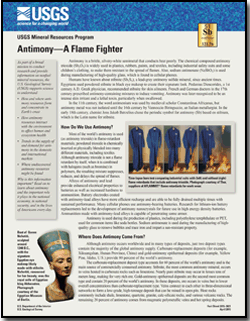 |
Antimony is a brittle, silvery-white semimetal that conducts heat poorly. The chemical compound antimony trioxide (Sb2O3) is widely used in plastics, rubbers, paints, and textiles, including industrial safety suits and some children’s clothing, to make them resistant to the spread of flames. Also, sodium antimonate (NaSbO3) is used during manufacturing of high-quality glass, which is found in cellular phones. Humans have known about stibnite (Sb2O3), a lead gray antimony sulfide mineral, since ancient times. Egyptians used powdered stibnite in black eye makeup to create their signature look. Pedanius Dioscorides, a 1st century A.D. Greek physician, recommended stibnite for skin ailments. French and German doctors in the 17th century prescribed antimony-containing mixtures to induce vomiting. Antimony was later recognized to be an intense skin irritant and a lethal toxin, particularly when swallowed. |
 |
Geologic Map of the Bodie Hills, California and Nevada The Bodie Hills covers about 1,200 km2 straddling the California-Nevada state boundary just north of Mono Lake in the western part of the Basin and Range Province, about 20 km east of the central Sierra Nevada. The area is mostly underlain by the partly overlapping, middle to late Miocene Bodie Hills volcanic field and Pliocene to late Pleistocene Aurora volcanic field (John and others, 2012). Upper Miocene to Pliocene sedimentary deposits, mostly basin-filling sediments, gravel deposits, and fanglomerates, lap onto the west, north, and east sides of the Bodie Hills, where they cover older Miocene volcanic rocks. Quaternary surficial deposits, including extensive colluvial, fluvial, glacial, and lacustrine deposits, locally cover all older rocks. Miocene and younger rocks are tilted ≤30° in variable directions. These rocks are cut by several sets of high-angle faults that exhibit a temporal change from conjugate northeast-striking left-lateral and north-striking right-lateral oblique-slip faults in rocks older than about 9 Ma to north- and northwest-striking dip-slip faults in late Miocene rocks. The youngest faults are north-striking normal and northeast-striking left-lateral oblique-slip faults that cut Pliocene-Pleistocene rocks. Numerous hydrothermal systems were active during Miocene magmatism and formed extensive zones of hydrothermally altered rocks and several large mineral deposits, including gold- and silver-rich veins in the Bodie and Aurora mining districts.
|
 |
The Rare-Earth Elements—Vital to Modern Technologies and Lifestyles Until recently, the rare-earth elements (REEs) were familiar to a relatively small number of people, such as chemists, geologists, specialized materials scientists, and engineers. In the 21st century, the REEs have gained visibility through many media outlets because of (1) the public has recognized the critical, specialized properties that REEs contribute to modern technology, as well as (2) China's dominance in production and supply of the REEs and (3) international dependence on China for the majority of the world's REE supply. Since the late 1990s, China has provided 85–95 percent of the world’s REEs. In 2010, China announced their intention to reduce REE exports. During this timeframe, REE use increased substantially. REEs are used as components in high technology devices, including smart phones, digital cameras, computer hard disks, fluorescent and light-emitting-diode (LED) lights, flat screen televisions, computer monitors, and electronic displays. Large quantities of some REEs are used in clean energy and defense technologies. Because of the many important uses of REEs, nations dependent on new technologies, such as Japan, the United States, and members of the European Union, reacted with great concern to China’s intent to reduce its REE exports. Consequently, exploration activities intent on discovering economic deposits of REEs and bringing them into production have increased. |
 |
Along the Colorado River corridor between Glen Canyon Dam and Lees Ferry, Arizona, located some 25 km downstream from the dam, archaeological sites dating from 8,000 years before present through the modern era are located within and on top of fluvial and alluvial terraces of the prehistorically undammed river. These terraces are known to have undergone significant erosion and retreat since emplacement of Glen Canyon Dam in 1963. Land managers and policy makers associated with managing the flow of the Colorado River are interested in understanding how the operations of Glen Canyon Dam have affected the archeological sites associated with these terraces and how dam-controlled flows currently interact with other landscape-shaping processes. In 2012, the U.S. Geological Survey initiated a research project in Glen Canyon to study the types and causes of erosion of the terraces. This report provides the first step towards this understanding by presenting comparative analyses on several types of high-resolution topographic data (airborne lidar, terrestrial lidar, and airborne photogrammetry) that can be used in the future to document and analyze changes to terrace-based archaeological sites. |